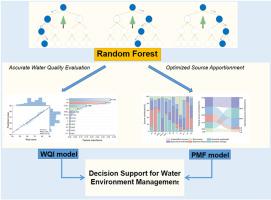当前位置:
X-MOL 学术
›
Environ. Pollut.
›
论文详情
Our official English website, www.x-mol.net, welcomes your feedback! (Note: you will need to create a separate account there.)
Deep optimization of water quality index and positive matrix factorization models for water quality evaluation and pollution source apportionment using a random forest model
Environmental Pollution ( IF 8.9 ) Pub Date : 2024-03-15 , DOI: 10.1016/j.envpol.2024.123771 Han Zhang , Xingnian Ren , Sikai Chen , Guoqiang Xie , Yuansi Hu , Dongdong Gao , Xiaogang Tian , Jie Xiao , Haoyu Wang
Environmental Pollution ( IF 8.9 ) Pub Date : 2024-03-15 , DOI: 10.1016/j.envpol.2024.123771 Han Zhang , Xingnian Ren , Sikai Chen , Guoqiang Xie , Yuansi Hu , Dongdong Gao , Xiaogang Tian , Jie Xiao , Haoyu Wang

|
Effective evaluation of water quality and accurate quantification of pollution sources are essential for the sustainable use of water resources. Although water quality index (WQI) and positive matrix factorization (PMF) models have been proven to be applicable for surface water quality assessments and pollution source apportionments, these models still have potential for further development in today's data-driven, rapidly evolving technological era. This study coupled a machine learning technique, the random forest model, with WQI and PMF models to enhance their ability to analyze water pollution issues. Monitoring data of 12 water quality indicators from six sites along the Minjiang River from 2015 to 2020 were used to build a WQI model for determining the spatiotemporal water quality characteristics. Then, coupled with the random forest model, the importance of 12 indicators relative to the WQI was assessed. The total phosphorus (TP), total nitrogen (TN), chemical oxygen demand (COD), dissolved oxygen (DO), and five-day biochemical oxygen demand (BOD) were identified as the top five significant parameters influencing water quality in the region. The improved WQI model constructed based on key parameters enabled high-precision (R = 0.9696) water quality prediction. Furthermore, the feature importance of the indicators was used as weights to adjust the results of the PMF model, allowing for a more reasonable pollutant source apportionment and revealing potential driving factors of variations in water quality. The final contributions of pollution sources in descending order were agricultural activities (30.26%), domestic sewage (29.07%), industrial wastewater (26.25%), seasonal factors (6.45%), soil erosion (6.19%), and unidentified sources (1.78%). This study provides a new perspective for a comprehensive understanding of the water pollution characteristics of rivers, and offers valuable references for the development of targeted strategies for water quality improvement.
中文翻译:

利用随机森林模型对水质指数和正矩阵分解模型进行深度优化,用于水质评价和污染源解析
有效的水质评价和准确的污染源量化对于水资源的可持续利用至关重要。尽管水质指数(WQI)和正矩阵分解(PMF)模型已被证明适用于地表水质量评估和污染源解析,但在当今数据驱动、快速发展的技术时代,这些模型仍然具有进一步发展的潜力。这项研究将机器学习技术、随机森林模型与 WQI 和 PMF 模型相结合,以增强其分析水污染问题的能力。利用2015—2020年岷江沿线6个站点12个水质指标的监测数据,建立WQI模型,确定水质时空特征。然后,结合随机森林模型,评估了12个指标相对于WQI的重要性。总磷(TP)、总氮(TN)、化学需氧量(COD)、溶解氧(DO)、五日生化需氧量(BOD)被确定为影响区域水质的前5位重要参数。基于关键参数构建的改进WQI模型实现了高精度(R = 0.9696)水质预测。此外,还利用指标的特征重要性作为权重来调整PMF模型的结果,从而能够更加合理地进行污染物源解析,揭示水质变化的潜在驱动因素。最终污染源贡献由大到小依次为:农业活动(30.26%)、生活污水(29.07%)、工业废水(26.25%)、季节因素(6.45%)、水土流失(6.19%)、不明来源(1.78)。 %)。该研究为全面认识河流水污染特征提供了新的视角,为制定针对性的水质改善策略提供了有价值的参考。
更新日期:2024-03-15
中文翻译:

利用随机森林模型对水质指数和正矩阵分解模型进行深度优化,用于水质评价和污染源解析
有效的水质评价和准确的污染源量化对于水资源的可持续利用至关重要。尽管水质指数(WQI)和正矩阵分解(PMF)模型已被证明适用于地表水质量评估和污染源解析,但在当今数据驱动、快速发展的技术时代,这些模型仍然具有进一步发展的潜力。这项研究将机器学习技术、随机森林模型与 WQI 和 PMF 模型相结合,以增强其分析水污染问题的能力。利用2015—2020年岷江沿线6个站点12个水质指标的监测数据,建立WQI模型,确定水质时空特征。然后,结合随机森林模型,评估了12个指标相对于WQI的重要性。总磷(TP)、总氮(TN)、化学需氧量(COD)、溶解氧(DO)、五日生化需氧量(BOD)被确定为影响区域水质的前5位重要参数。基于关键参数构建的改进WQI模型实现了高精度(R = 0.9696)水质预测。此外,还利用指标的特征重要性作为权重来调整PMF模型的结果,从而能够更加合理地进行污染物源解析,揭示水质变化的潜在驱动因素。最终污染源贡献由大到小依次为:农业活动(30.26%)、生活污水(29.07%)、工业废水(26.25%)、季节因素(6.45%)、水土流失(6.19%)、不明来源(1.78)。 %)。该研究为全面认识河流水污染特征提供了新的视角,为制定针对性的水质改善策略提供了有价值的参考。



























 京公网安备 11010802027423号
京公网安备 11010802027423号